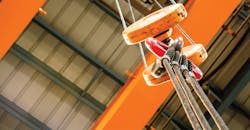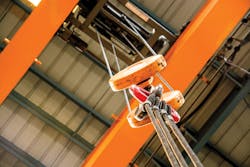Mention the word “crane,” and most people think of the massive construction cranes used to erect skyscrapers. Electricians don’t operate these big cranes, but on some jobs an electrician might operate a crane or hoist several times a day. A maintenance electrician might operate a crane to remove an old motor, and then use it again to set a new motor in place. A construction electrician might operate a hoist to set a panel at the desired height as part of mounting the panel. How do these two types of equipment differ?
• A hoist can lower or raise a load. The load might hang from a hook directly under the hoist body or be suspended from an arm for some (fixed distance) horizontal reach. A hoist might be rail-mounted, and it might carry several tons along that rail from one end of a building to the other. Regardless of the type of hoist, it is incapable of moving the load horizontally. You can define the primary danger zone of a hoist as being “under the load.”
• A crane is also used to lower or raise a load, but it can also move the load horizontally. Like hoists, cranes come in many configurations. A crane’s primary danger zone is not just “under the load,” but also anywhere the crane may move the load horizontally (up to 360º, depending upon the crane design).
Article 610 of the 2017 National Electrical Code (NEC) provides electrical requirements for installing cranes and hoists. Glancing at Table 610.14(A), which provides ampacities, you can see these range in size from a crane motor that draws enough current to require 500kcmil conductors to one that needs only 16 AWG conductors.
Not all cranes and hoists are electrically powered, however. Some hoists are even chain-operated; the user pulls chains to rotate pulleys. A crane may have a mechanical system for articulating the boom and be combined with a hydraulic hoist for lifting the load.
OSHA has requirements for cranes and hoists (see The OSHA Regs). Your company also has a policy (as mandated by OSHA) for them. You should be familiar with the general safety practices that apply to you. The safety practices for cranes and hoists differ, depending on many factors, including:
• Type of crane or hoist.
• Application (location and load).
• Your role in the usage.
The actors in this play
Three kinds of actors are involved in crane safety:
1. Non-operator. You’re not involved in the lift. You might be working in or near the area, or just walking through it. Unlike pedestrians on city streets, non-operators don’t have the right of way. Think more in terms of “stay out of the way.”
2. Operator. You might be operating the crane or hoist. You have some responsibilities to fulfill before using the equipment and others to fulfill while using it.
3. Signal person. In some load-moving situations, it’s not feasible for one person to operate the crane or hoist and watch for everything else. That’s where a signal person comes in. In this role, you’re responsible for providing clear and
accurate signals to the operator.
At a manufacturing plant, two electricians might work together to raise a motor to the mezzanine on which it will be installed. Each views the operation from a different angle. Bill operates the pendant-style controls from the mezzanine, while maintaining visual contact with Jim who is on the ground directing the lift. Being a qualified signal person, Jim uses standard hand signals.
Now John is walking by, and stops to ask Jim a question. John just committed an unsafe act by attempting to distract a signal person.
Being a safe non-operator
The signal person (if there is one) and the operator will do their best to ensure the safety of people who are not in the operating crew, but if you’re a non-operator, then you must do your part also. If you’re near the operating area, you have safety responsibilities even if you’re not involved in using the equipment. Follow these rules:
• Obey warning signs, such as yellow or red barrier tape. Yellow means caution (danger is present), red means stay out. Generally, treat yellow as “stay out” unless you have a compelling reason to cross the barrier. Only the operating crew can be “inside” the red tape; cross that only in dire emergency (e.g., signal person has a medical emergency).
• Don’t be there. If possible, leave the area even if you’re on the “safe” side of the yellow tape. If a danger is present, your first line of defense is to not be present yourself.
• Stay alert. If you must approach a lifting operation area, pay attention to the operator, load, and signal person. Do not try to draw their attention, except to warn of immediate danger.
• Eliminate distraction. If you are walking through the yellow-taped area with another person, do not be distracted by chit-chat. Your mission is to make it safely through the area, so stay alert. If your phone signals you have a text or call, ignore that until you are in a place where it’s safe to have your attention diverted to the phone.
• The crane operator must receive information from only one person. Don’t interfere with the designated signal person; everyone else must refrain from signaling the operator in any way.
• The signal person outranks even the company CEO during the operation. Follow any instructions given by this person. If you disagree with the signal person, don’t argue. Instead, leave the area, and discuss the issue when the signal person isn’t occupied with the operation.
• If you suddenly realize you’re where in the wrong place (e.g., under the load), immediately move yourself out of the way. Don’t distract the operator or signal person by apologizing.
Being a safe operator
Operators obviously have safety requirements to meet. Here are some:
• Before using the equipment, examine its inspection record, test the controls, and ensure the proper warnings (e.g., barrier tape) are in place.
• If you’re not qualified on that specific equipment, don’t operate it.
• Don’t let anyone ride along with the load.
• Signal before and during a movement.
• If people are on the path over which you intend to move the load, get them out of the way. A work stoppage to move people to safety is preferable to a work stoppage to scrape them up after a load falls on them.
• What if the load travel path was clear, but someone walked onto it during crane boom movement? Rather than risk dropping the load due to a sudden stop, keep course and speed steady. The signal person should remove that person.
• If a load seems wrong in any way (e.g., unbalanced or slung improperly), lower it, and fix the problem.
Being a safe signal person
The signal person can prevent most safety problems simply by asserting the authority that role provides. If you’re the signal person:
• Take command of the area where the movement is taking place.
• Focus. Your job requires your full attention.
• Be aware of what’s going on in and near the operation area.
• If others enter your area, tell them to leave. You may need to signal the crane operator to stop until the situation is resolved. Interference with your duties is typically a terminable offense; report problem individuals to a nearby supervisor or have a non-operator bring a supervisor to you.
Top 10 tips
Let’s close with 10 tips for crane and hoist safety. Only the last two apply specifically to operators.
1. Don’t let unqualified (on that specific equipment) people operate the equipment.
2. Each of the three types of actors has safety responsibilities; know your role and your responsibilities.
3. You can ride a personnel lift. You can’t ride a materials lift.
4. If you’re not with the lifting crew, try to “not be there” during the lift.
5. Unless you’re the signal person, don’t try to communicate with the operator.
6. The area under the load is the prime danger zone; never be in that zone. Where cranes are involved, this zone moves.
7. A pedestrian has the right of way on city streets. The crane crew (operator and signal person) has the right of way in the operating area of the crane or hoist.
8. Watch the load for signs of instability.
9. As the operator, test the controls before operating the equipment.
10. As the operator, signal before and during the lift.
Lamendola is an electrical consultant located in Merriam, Kan. He can be reached at [email protected].
Sidebar: The OSHA Regs
OSHA regulations for cranes are in 29CFR-1926.550. OSHA regulations for hoists are in 29CFR-1926.552, .553, and .554.
About the Author

Mark Lamendola
Mark is an expert in maintenance management, having racked up an impressive track record during his time working in the field. He also has extensive knowledge of, and practical expertise with, the National Electrical Code (NEC). Through his consulting business, he provides articles and training materials on electrical topics, specializing in making difficult subjects easy to understand and focusing on the practical aspects of electrical work.
Prior to starting his own business, Mark served as the Technical Editor on EC&M for six years, worked three years in nuclear maintenance, six years as a contract project engineer/project manager, three years as a systems engineer, and three years in plant maintenance management.
Mark earned an AAS degree from Rock Valley College, a BSEET from Columbia Pacific University, and an MBA from Lake Erie College. He’s also completed several related certifications over the years and even was formerly licensed as a Master Electrician. He is a Senior Member of the IEEE and past Chairman of the Kansas City Chapters of both the IEEE and the IEEE Computer Society. Mark also served as the program director for, a board member of, and webmaster of, the Midwest Chapter of the 7x24 Exchange. He has also held memberships with the following organizations: NETA, NFPA, International Association of Webmasters, and Institute of Certified Professional Managers.

